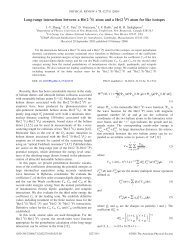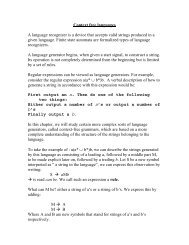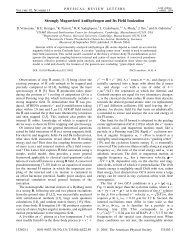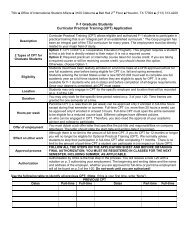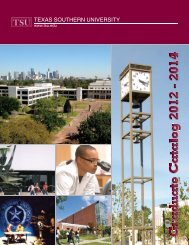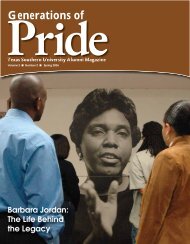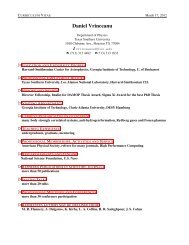2001-2003 Graduate Catalog - Texas Southern University: ::em.tsu ...
2001-2003 Graduate Catalog - Texas Southern University: ::em.tsu ...
2001-2003 Graduate Catalog - Texas Southern University: ::em.tsu ...
Create successful ePaper yourself
Turn your PDF publications into a flip-book with our unique Google optimized e-Paper software.
CHOICE OF MAJOR ADVISERAt the time of admission each student will be assigned to a graduate student adviser. The graduate student adviser willadvise the student until he/she chooses an area of special interest. Then, each student will interview at least three facultym<strong>em</strong>bers concerning their research interests and involv<strong>em</strong>ents. After these interviews, the student will select a professorwho agrees to serve as his/her major adviser and chair of the thesis or dissertation committee. The committee will be composedof at least three persons from the environmental toxicology faculty. The <strong>Graduate</strong> School dean will assign a graduaterepresentative from outside the environmental toxicology faculty to join the committee when it is formed.DISSERTATIONThe Ph.D. is primarily a research degree and the student is expected to d<strong>em</strong>onstrate the ability to design a research project,to impl<strong>em</strong>ent it, contribute new knowledge to the field of study and write an acceptable dissertation. The dissertation topicand the nature and extent of the research will be recommended by the student and his/her adviser for approval by the dissertationcommittee. The format of the dissertation, described in a booklet from the <strong>Graduate</strong> Office, must be followed. Thedissertation must be defended before the committee in an oral examination. Certification of successful completion of theOral Examination requires the signature of all m<strong>em</strong>bers of the dissertation committee. A student who fails the final oralexamination on the dissertation may petition the Dean of the <strong>Graduate</strong> School through the department for a second att<strong>em</strong>ptto pass the examination. The second att<strong>em</strong>pt cannot be made until at least on s<strong>em</strong>ester has passed since the first att<strong>em</strong>pt.All changes in the dissertation suggested by the committee after the Oral Examination must be made before the dissertationcan receive the final approval of the <strong>Graduate</strong> School. In addition to the dissertation, the student is required to condensethe dissertation or a portion of it into a paper suitable for publication in a refereed journal. This paper must accompany thedissertation when it is presented to the m<strong>em</strong>bers of the committee. In addition, an abstract, not exceeding 350 words mustbe prepared for submission to <strong>University</strong> Microfilms Incorporated.CURRICULUMThe objective of the environmental toxicology program of study is to provide training which will enable students to applythe principles and methods of the physical and biological sciences to the study of toxicants as a basis for solving probl<strong>em</strong>soccasioned by the presence of toxicants in the environment. While the <strong>em</strong>phasis in the master’s program will be on coursework, the Ph.D. degree curriculum is designed to produce graduates who are highly skilled in designing and impl<strong>em</strong>entingresearch studies, analyzing data and applying results that may be used in the formulation of policies and plans for a morehealthy environment. Students may take electives drawn from existing courses in environmental law, health sciences, technologyand manag<strong>em</strong>ent.Students in both the MS and Ph.D. degree programs will study the properties, fate, biological effects, detection and regulationof natural and man-made toxicants present in the environment. Toxicants may include air, water and soil pollutants suchas pesticides, industrial ch<strong>em</strong>icals, and poisons produced by microbes, plants, and animals. The program for Ph.D. degreestudents will have a strong <strong>em</strong>phasis on research.Students working toward the Master’s program must complete 30 s<strong>em</strong>ester credit hours (SCH) of courses and 6 SCH ofresearch. Students working toward the Ph.D. degree must complete a residency as shown in a degree plan that includescourses that support the specialization that the student seeks to achieve. The residency must show a minimum full-timecourse load taken in two consecutive s<strong>em</strong>esters or one s<strong>em</strong>ester of full-time study preceded or followed by two summerterms of full-time course work. Students holding only a Bachelor’s degree who are admitted to the Ph.D. degree programmust complete all of the courses required in the Master’s program in environmental toxicology. Likewise, Master’s degreeholders admitted to the Ph.D. degree program must also show that they have satisfied the course requir<strong>em</strong>ents or equivalentsin the Master’s degree program in environmental toxicology. In addition, all doctoral students must complete the Ph.D.program requir<strong>em</strong>ents.RESEARCH TOPICSStudents may pursue research probl<strong>em</strong>s in the following areas: Air, Water, Soil pollution; Genetic Toxicology; Ch<strong>em</strong>istryand Fate of Pesticides; Pathogenesis of Toxicants; Natural Toxicants.51



